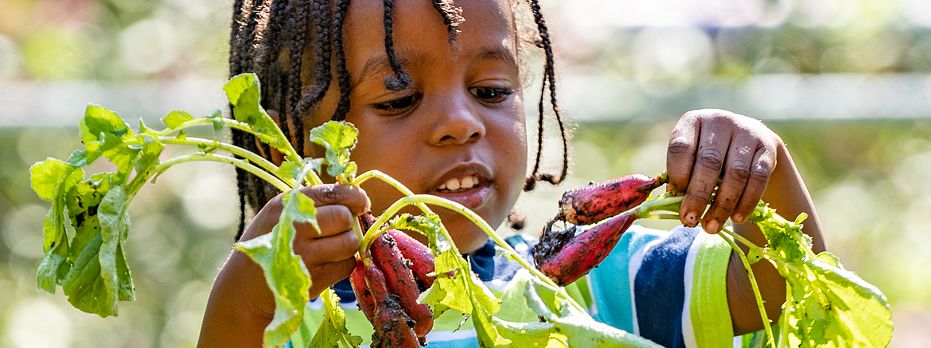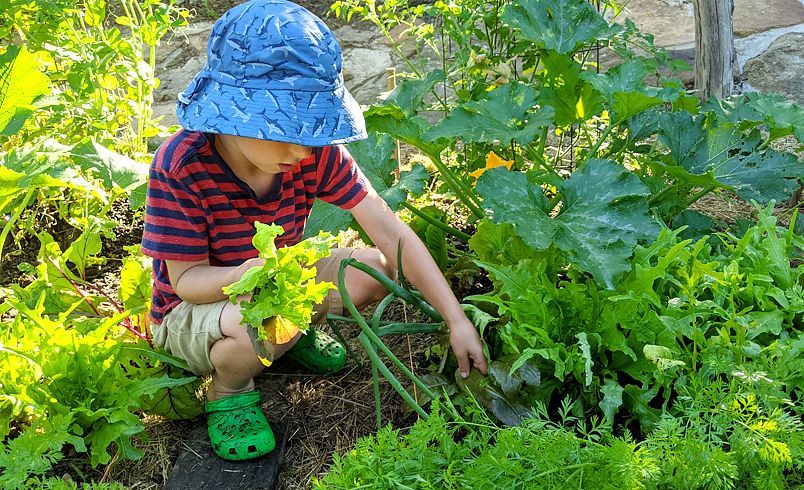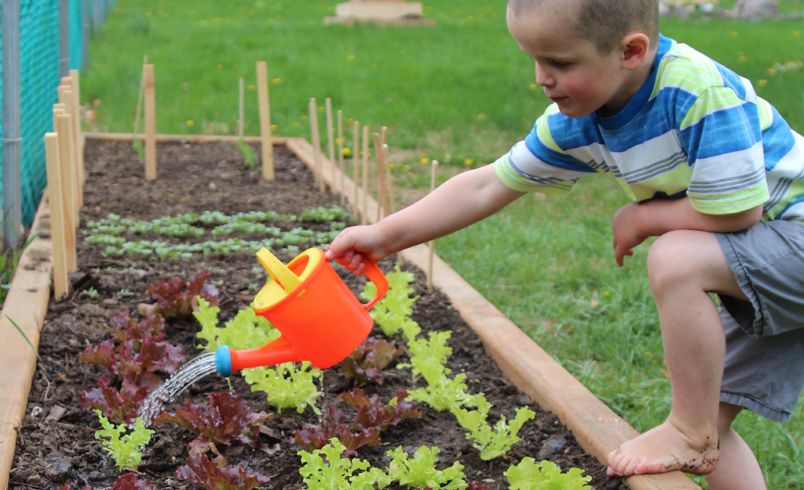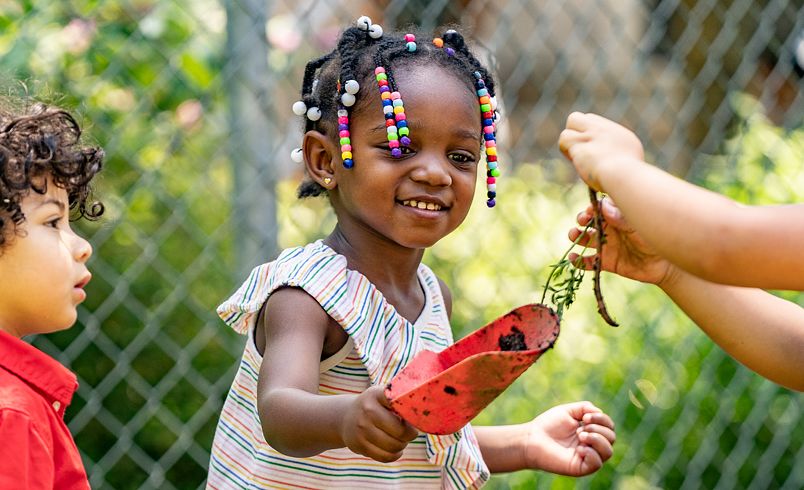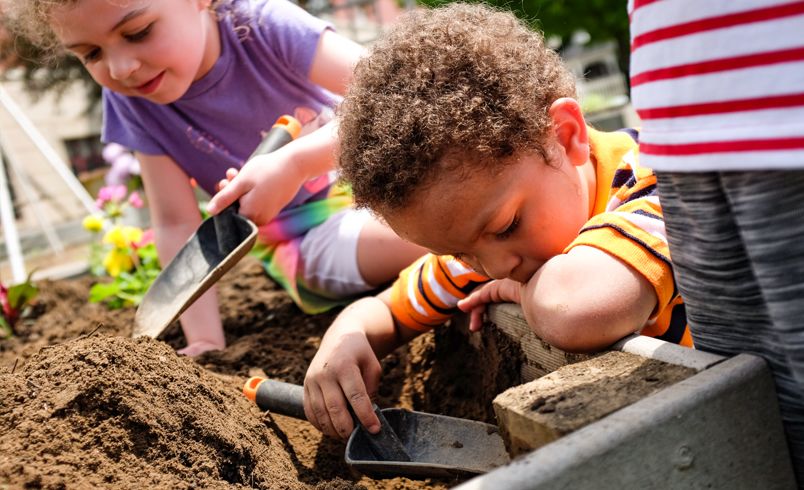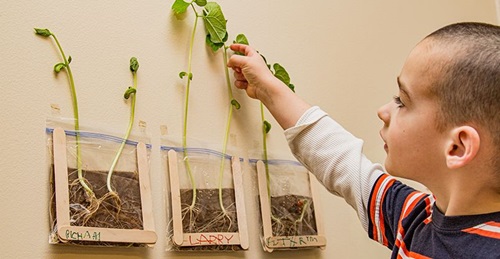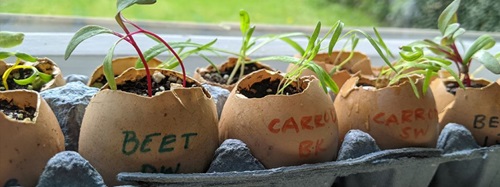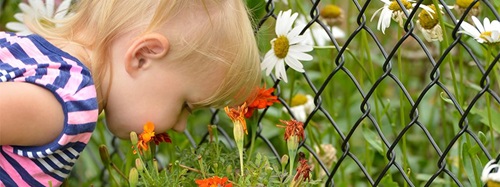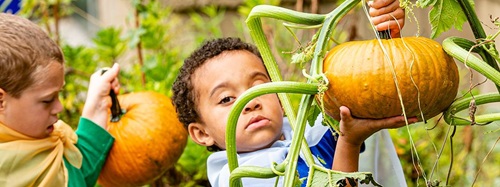Gardening with Children
| April 2014In my experience, gardening with young children isn’t nearly as romantic in practice as most people think. Yes, it’s fun; and yes, there are moments of wonder and discovery. But gardening with a group of young children, many of who would rather be playing than following careful instructions, is seldom as calm, intentional, or controlled as most teachers hope it will be. Instead, it’s about seeds being scattered in clumps and piles. It’s about far too much water being poured in one spot and next-to-no water reaching another. It’s about digging holes, but then getting tired and demanding that someone else finish the job. It’s about plants being dug up to see the progress at the other end. Or green cherry tomatoes being pulled off the vine and squashed or tossed at each other, for fun.
On the other hand, it is also possible to head outside with baskets and kid scissors to cut down giant kale leaves; we’ve done that, and then roasted them into kale chips. We’ve picked fresh lettuce leaves and sugar snap peas and dipped them in salad dressing. We’ve eaten raw chives, roasted tomatoes, and ground up nut-free pesto to eat with pasta back in the classroom.
Gardening with children is like most sensory experiences with three and four year-olds. It’s messy, it’s chaotic, and the more children you add to the scenario, the more instruction goes out the window and you just hope something is getting through.
The amazing thing is that something always does. The children remember days, weeks, even months later that they picked a chive from the garden and ate it on the spot. They remember that they cooked something inside that they grew themselves outside. They make the connection that the food we eat starts in the soil, and when they find worms after a rain storm, they often decide the worms need new homes over in our garden beds, because after all, the more worms, the better the dirt.
They do not make neat rows. They do not tenderly care for each young plant (at least in my experience) nurturing it until it blossoms. They water the leaves and flower petals rather than the roots. They accidentally step on new seedlings. They pull up healthy plants along with weeds. For most children, gardening is just another form of play: there’s dirt, there’s water, there are fun tools like shovels and hoes; there are even sprinklers on hot days. But like all play, there is learning going on beneath the surface, just out of sight. It’s the kind that occurs without the child even being aware of it.
The first garden I ever developed with a group of young children was in North Philadelphia, at an inner-city elementary school surrounded by concrete. All we had to work with was an eight foot square where an old piece of sidewalk had been cracked and removed. I was lucky enough to get several donations for gardening supplies from local gardening centers, including a few pots, some kid-friendly shovels, and a couple of bags of topsoil. That was it but it was a start. For several days in a row, for no more than 30 minutes at a time, I would work with children ages three to five to get the soil into planting condition; this mostly meant I did the real work, and they scooped and tilled as best they could, but for many of the kids involved, it was the first time in their lives they had literally sat down and played in the dirt, and this fact mattered so much more than whether they did a good job with their tools. Later, we added a hodgepodge of flowers and vegetables, based mostly on donations from people I knew. I wasn’t sure our garden would ever be anything more than a single season “learning experience” and I reminded myself that with very young children it is the process more than the product that matters.
But then, magically, others began to take notice. Potted flowers began showing up overnight, delivered by people from the neighborhood who wanted to see our garden success; parents stopped by and asked if we needed anything. The garden began to expand. It was mostly a container garden, but it belonged to the children; it belonged to the families; and to the people who lived close enough to see its progress. When I left that summer to start a new life in Wisconsin, the garden had ceased to be mine—which was fine. Children need to feel ownership over a piece of soil in order to love it. It didn’t matter that there were weeds. Far better for a child to love a weed, to water it daily and tend to its progress, than to admire a healthy robust rose bush they are forbidden to touch.
Flash forward ten years. I have been working at the Schlitz Audubon Nature Preschool in Milwaukee, Wisconsin since 2008, and for the past six years I have taught numerous gardening programs with children. Although our growing season is short, it is rich. We have planted tomatillos, autumn greens, mini pumpkins; scarlet beans; purple carrots; and butternut squash. We have studied worms and composting; we have prepared zucchini bread, mango salsa, cucumber sandwiches, pizza, ice cream, and more using fresh ingredients that we planted ourselves. We have lost plants to deer, rabbit, ground squirrel, raccoon, mice, and wild turkey. We have attempted sensory gardens; pizza gardens; butterfly gardens; and even a dessert garden in which we planted chocolate mint; stevia; and blueberry bushes. (Here’s a suggestion to anyone thinking of starting a garden with children: stay away from chocolate mint unless you can contain it properly!)
During that time, there were many hits and misses. In one instance a young boy decided the most efficient way to water the plants was to use biology to his advantage. His mother was horrified, but a little research revealed that human urine is actually beneficial to gardens as its high nitrogen count acts as a liquid fertilizer. In another instance, we had to limit the amount of dirt a particular child could consume, since dirt, we explained almost daily, was not food. “It is for worms,” he argued. I have no doubt he’ll go far. (This is perhaps the right time to mention that there can be a certain amount of risk involved in gardening with small children. The best way to manage risk, of course, is to use common sense, and to be preemptive about removing poisonous plants and stinging nettles, to avoid fertilizers and chemical sprays, and to remind children to never, ever eat plants that haven’t been properly identified by a grown up.)
The point, of course, is that gardening with children is unpredictable, frustrating, risky, and yet. quite often a delight: much like gardening itself. Just as we can’t control the weather, or know in advance which seeds will thrive, we can’t force children to sit on the sidelines and simply watch, and expect them to care. They need to be in the garden, touching, tasting, and to some extent destroying, in order to experience the absolute wonder of life springing from what seems like nothing, a life that we helped nourish, and that will in turn nourish us.
At a time when more and more children are disconnected from nature, at a time when they are indoors more than out, literally opting for virtual gardens over real ones, I would encourage anyone who has ever considered planting a garden with children (or even just one child) to do so. I don’t have a blueprint for how to get started. Each garden is different. But if you have access to dirt, you can plant. And if you make mistakes, well, that’s part of the fun.
These days, I have given up on elaborate themes and stick with things that I know will work in our preschool garden, which sits on a bluff above Lake Michigan. We plant herbs, because they smell terrific and they can be dried for the winter and hung in our classrooms. We plant native prairie plants because those are the plants that thrive in Wisconsin and that provide food and shelter for the creatures that live here. We plant tomatoes because they are easy, and because nearly all kids like pizza; and we plant chives because I have yet to meet a child who isn’t at least tempted to pick off the end of a chive and nibble it, even knowing that it’s a kind of onion.
My co-teachers and I are less concerned with the health of our garden and are more concerned with being in the garden. Our warm weather classes include music and stories in the garden; we have watering cans out during play time; we’ll sit by the plants with paper and paints and while some children choose paint what they see, others prefer to paint robots, or to just dip their brush into every color and create muddy rainbows across their paper. It’s not about what they create; it’s about feeling the sun on our faces, seeing the flowers bend in the breeze, and smelling the basil as we sit with our friends. The point is for us to surrender, as adults, our ownership over the garden and give it back to the children. Of course that is what we do, all the time, as teachers, as parents, and adults. Our job is to help plant the seeds and then step back and watch them grow.

